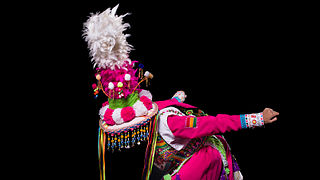 W
WThe Caporales is a traditional Bolivian dance originated in Barrio Chijini del Gran Poder in La Paz City. The Caporales dance were created and presented to the public for the first time in 1969 by the Estrada Pacheco brothers, who were inspired in the Caporal, this character was the overseer of the black slaves in Los Yungas and was usually mixed race, wore boots and held a whip.
 W
WCueca is a family of musical styles and associated dances from Chile, Argentina, and Bolivia. In Chile, the cueca holds the status of national dance, where it was officially declared as such by the Pinochet dictatorship on September 18, 1979.
 W
WThe Diablada, also known as the Danza de los Diablos, is an Andean folk dance performed in the Altiplano region of South America, characterized by performers wearing masks and costumes representing the devil and other characters from pre-Columbian theology and mythology. combined with Spanish and Christian elements added during the colonial era. Many scholars have concluded that the dance is descended from the Llama llama dance in honor of the Uru god Tiw, and the Aymaran ritual to the demon Anchanchu, both originating in pre-Columbian Bolivia, though there are competing theories on the dance's origins.
 W
WThe Kullawada, kullahuada, cullaguada or kullawa is an Aymara dance, an indigenous people that since pre-Columbian times and even today inhabit the Peruvian-Bolivian highlands, on the shores of Lake Titicaca. The name of the dance derives from the word kullawa, in reference to its dancers. It is represented both in Bolivia, in the Carnival of Oruro; as in Peru, in the Fiesta de la Candelaria.
 W
WThe Llama llama, also spelled Llamallama or Lama lama, was probably a dance with the characteristics of a farce or a disguise game with acrobatic elements. It is believed that the name of the dance came from the Aymara language, which was the name the Aymara people used to describe the Urus dressed as dancing demons.
 W
WThe Saya or saya afroboliviana is a music and dance that originated in the Afro-Bolivian community in Los Yungas of Bolivia. The Saya's instrumentation and dance reflects the influence of African percussion and rhythms.
 W
WTinku, a Bolivian Aymara tradition, began as a form of ritualistic combat. In the Quechua language, it means “meeting-encounter". During this ritual, men and women from different communities will meet and begin the festivities by dancing. The women will then form circles and begin chanting while the men proceed to fight each other; rarely the women will join in the fighting as well. Large tinkus are held in Potosí during the first few weeks of May.